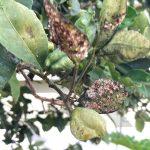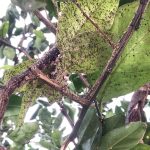The orange tree at my house seems to have a major infestation of some sort. Could you please help me identify this, and suggest any intervention you think might work?


Your photos are suggestive of an infestation of aphids, with both nymph and winged adults seen in your well taken photos. A few mealybugs are also present, but the major problem is aphids, a common problem of Hawaii’s citrus. Many types of aphids use citrus as their host, and fortunately, their presence is usually not in such abundance that they require treatment with commercial broad-spectrum pesticides. In fact, broad spectrum insecticides will kill the aphid’s natural predators and beneficial insects such as lady beetles and parasitic wasps, so you want to avoid their use. Strangely, the recent storm we had may have given you some assistance in getting rid of the aphids, since one of the simplest treatments for aphids is a high-powered water spray from a hose with a nozzle spray strong enough to knock the aphids off. As seen in your photos, aphids can be present on both sides of the leaf, usually with the underside (where they feed) more colonized. When spraying with the hose, you want to make certain that you get both sides, but especially the underside of the leaves. Hose spraying should be done every 3-4 days until the aphids are controlled. Insecticidal soaps, which can be purchased at Lowes, Home Depot, and Ace, can also be used, as they will actually kill the aphids when used according to the directions and not just knock the aphids off. A recipe for homemade insecticidal soap is included in the CTAHR article about aphids that is attached and can be found at the end of the article. In areas where black sooty mold is seen, the leaves may actually have to be gently scrubbed with a damp cloth, as the sooty mold interferes with photosynthesis.
In order to keep your tree free of aphids, the ants, (who feed on the aphids’ honeydew and actually protect the aphids), must be controlled. This can usually be achieved with an ant bait product such as Terro.
Hawaii Master Gardener Program: FAQ Aphids
1026-1/6/2022-TF



